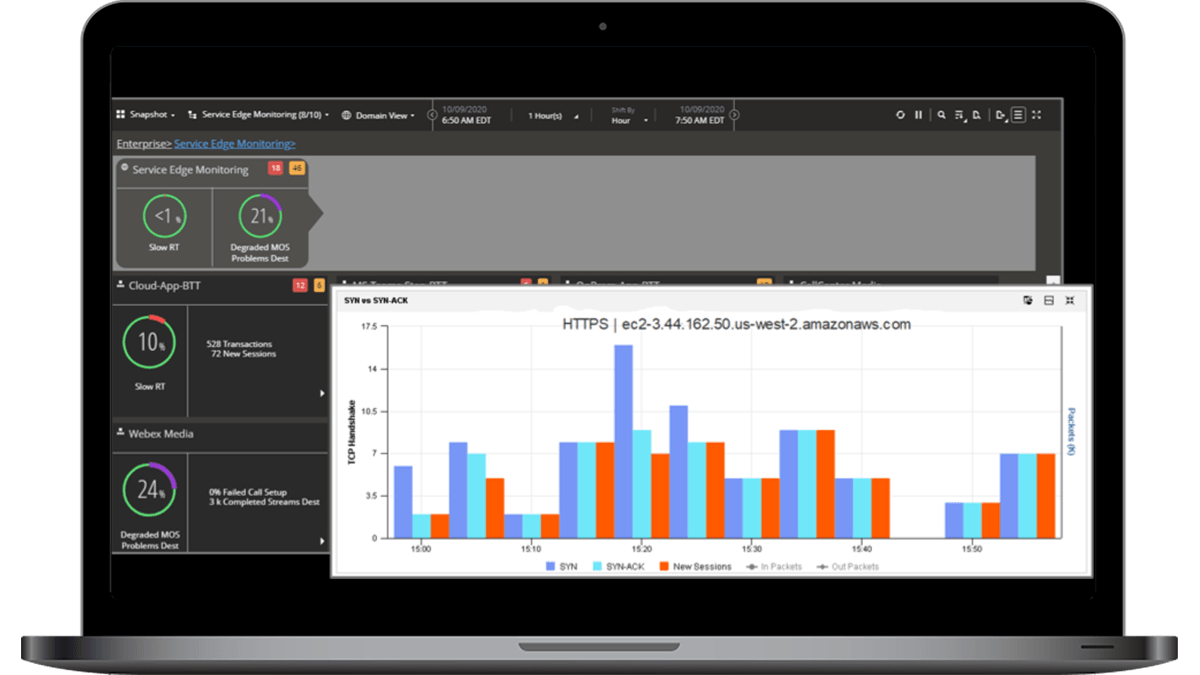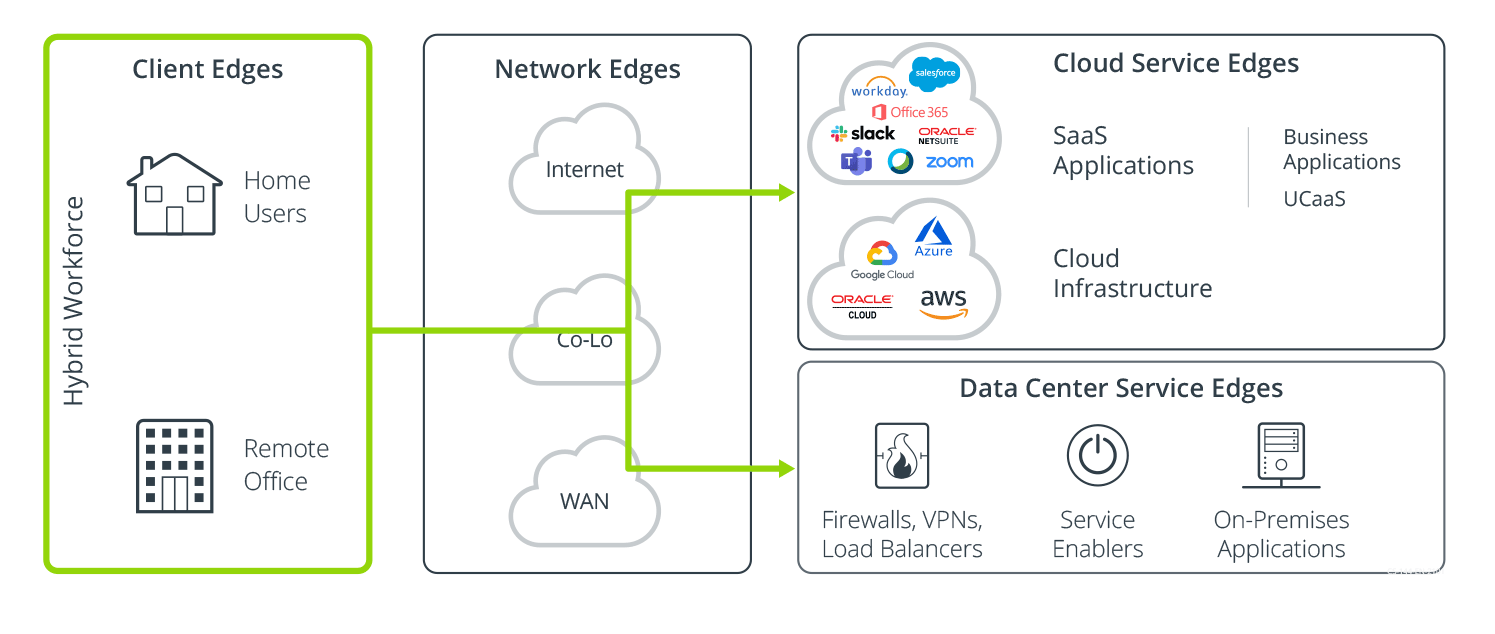
Eileen Haggerty
Area Vice President, Product and Solutions Marketing

What is the client edge?
Client edges are locations where an end-user or group of end-users (a.k.a., clients) connect to the network.
In the case of a single remote user, such as a work-from-home (WFH) employee, they will be using a company-issued laptop or workstation, their home Wi-Fi or local ethernet connection, and their local Internet circuit to gain access to the private corporate data center, public cloud, and co-location, and/or software as a service (SaaS) and unified communications as a service (UCaaS) applications to perform their job.
When the client edge represents a smaller remote location with a group of end-users, the employees connect to the network using shared infrastructure, e.g., the switch on a floor of a building, or a group of Wi-Fi access points with the same controller, and/or a WAN router to connect to the Interswitch links (ISLs).
What are service edges?
There are three general areas for visibility (location types) in today’s complex networks - Client, Network, and Data Center/Cloud Service Edges. Each of the three edges shares a common characteristic. This is where traffic is altered as it crosses domains between the edges. Examples include traffic from wireless to wired connections, or LAN to WAN, home network to ISP, or ISP to Co-Lo, Co-lo to cloud, cloud to application workload servers, etc. Each of these points of change is an edge that presents a potential gap in network visibility.
This is the landscape in a majority of today’s large corporations. They have multiple domains, which present the challenge of unmanaged edges. With visibility hindered at the edges, IT teams have described the situation with phrases like “losing sight of the remote workforce,” “emerging blind spots along the client edge,” or simply “loss of control.”

Figure 1: The three locations that exist across today’s complex, multi-cloud environments are the Client, Network, and Data Center/Cloud Service Edges.
What is packet-based monitoring?
The use of packet data and synthetic test technologies, or in some cases both, for monitoring at the client edge is a leap in visibility over what was available even just a few short years ago. Until recently, visibility was expensive, impractical, and silo-based in nature, making investments and usefulness unattractive. However, technology innovations and advancements have resulted in ideal alternatives to gain visibility at the client edge.
Packet-based monitoring leverages visibility into actual user traffic traversing the enterprise environments, seen as wire-data on north-south physical Ethernet segments, as well as across virtualized environments over east-west traffic paths. Monitoring actual user packets in a passive, non-intrusive manner provides consistent, real-time visibility that is essential to gain precise metrics on the actual activity of users as they interact with application services in their data centers, co-los, public cloud, and SaaS providers.
NETSCOUT solutions utilize packet data to enable rapid IT troubleshooting, predictive analysis, network topology and health diagnostics reporting.
What is the business impact of a poor end-user experience?
With virtually an infinite number of paths that a transaction can take from any client edge, it is no surprise that problems can emerge across the entire ecosystem. Intermittent problems can persist for hours, days, and weeks for some end-users.
Regardless of whether the problem impacts a single user or an entire community of users, they have the capacity to significantly impact a company in a variety of ways:
- Home-user employees may have disrupted conference meetings or dropped calls with colleagues/or home-based contact center agents experience poor quality customer calls
- Remote users at home, cafes, hotels may struggle to get access to corporate data centers over virtual private networks (VPN) or virtual desktop interfaces (VDI)
- Retail employees in stores may be unable to access inventory in distribution centers or other stores to help make a sale
- Call center agents working at home may have poor-quality calls that impact their customers’ experience or service
- Gas pumps may not be able to complete credit card authorizations, causing customers to drive to another station that will accept their credit card
- Healthcare workers using Internet of Things (IoT) devices may be delayed pulling up patient records
- Tellers at bank branches or customers at ATM kiosks may experience delays in processing financial transactions
- Production managers at manufacturing plants may have disruptions in their automated assembly lines or intermittent performance issues with inventory management or production applications
- Attorneys at remote law offices may have delays accessing corporate document management systems for client briefs and evidence
What these examples share is two-fold - first, there is the bottom-line impact to the business and second, these are complicated problems to troubleshoot and solve. The business impact can include:
- Loss in employee productivity
- Lower customer service and reduced customer loyalty
- Missed revenue opportunities
- Increased costs to make up for downtime due to disruptions, e.g., production line issues
- Time lost to ineffective troubleshooting for IT staff
- Damage to reputation if there is public exposure of the disruptions
- Potential penalties related to regulatory compliance requirements if there are specific failures
Optimizing digital user experience for work-from-home employees and remote offices has become a priority for many organizations recently.
What is synthetic test monitoring?
Synthetic or active monitoring simulates end-user actions with applications across an enterprise environment by providing scheduled, consistent tests, typically from a client perspective, that delivers detailed performance and availability analysis of targeted applications and/or network areas. Configurable tests that are run automatically from remote user locations, at set time intervals, that match user actions even when they are inactive, provide a rich set of monitoring metrics and trended information that can reveal subtle changes in many areas. These could include SaaS applications, UCaaS solutions, data center-based applications, and, even the impact of Wi-Fi or local Ethernet networks at remote locations that may have an overall impact on transaction performance from the client edge.
What is NETSCOUT Smart Edge Monitoring?
NETSCOUT's nGenius Enterprise Performance Management solutions deliver value by helping IT organizations better monitor, analyze, track, and trend network and application performance using both packet and synthetic test data for comprehensive, end-through-end assurance. The challenges of today’s distributed workforce, combined with the complexities of the digitally transformed, hybrid cloud environments have made assuring quality application performance for the user community difficult to deliver for IT teams. Smart Edge Monitoring, with integrated insight throughout the client, network, and data center/cloud service edges, is reducing gaps in visibility and delivering vendor-independent, end-through-end service assurance.
NETSCOUT solutions helps IT organizations reclaim control of their service delivery environment with visibility into virtually any client edge - employees working from home, bank branches, remote offices, or factory plants. Configurable, consistent, scheduled testing of critical business services is reducing downtime and improving employee productivity. This ultimately is optimizing the customer experience, improving quality communications and team collaboration, protecting revenue, reducing costs, and ensuring overall business continuity.
